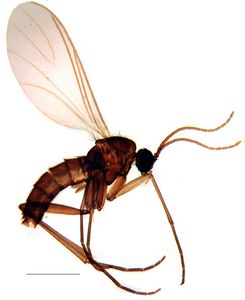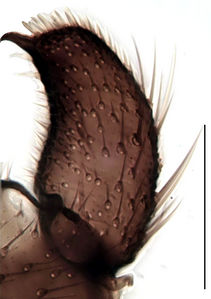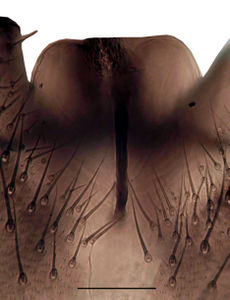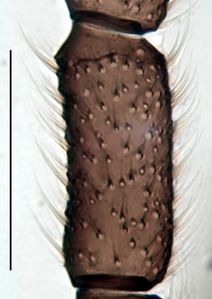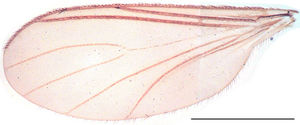Trichosiopsis coloniae
Ordo: Diptera
Familia: Sciaridae
Genus: Trichosiopsis
Name
Trichosiopsis coloniae unpublished
Type material
Holotype: ♂, 3.6.–7.6.2014, Malaise trap, leg. Rulik, ZFMK-TIS-2527974 in ZFMK
Type locality
Germany, North-Rhine-Westphalia, Bonn
Barcoded material
| Stadium | Country | Province | Locality | Habitat | Method | Date | Collector | Collection Number | Collection | Latitude | Longitude | Elevation (m) |
|---|---|---|---|---|---|---|---|---|---|---|---|---|
| 1 ♂ (holotype) | Germany | North-Rhine-Westphalia | Bonn, Museum Alexander Koenig | garden | Malaise trap | 3.6.–7.6.2014 | Björn Rulik | ZFMK-TIS-2527974 | ZFMK | 50.7219 | 7.1136 | |
| 1 ♀ | Germany | Rhineland-Palatinate | Niederzissen, Bausenberg | dry grassland | Malaise trap | 09.-24.04.2014 | Björn Rulik | ZFMK-TIS-2564772 | ZFMK | 50.4650 | 7.2261 | 292 |
| 1 ♂ | Bulgaria | Sofiya | Malaise trap | I. Iliev | BIOUG14949-C06 | BIOUG | 43.0090 | 23.0580 | ||||
| 1 ♂ | Bulgaria | Sofiya | Malaise trap | I. Iliev | BIOUG14949-C08 | BIOUG | 43.0090 | 23.0580 | ||||
| 1 | Bulgaria | Sofiya | Malaise trap | I. Iliev | BIOUG14949-A02 | BIOUG | 43.0090 | 23.0580 | ||||
| 1 | Bulgaria | Sofiya | Malaise trap | I. Iliev | BIOUG14949-D12 | BIOUG | 43.0090 | 23.0580 | ||||
| 1 | Bulgaria | Sofiya | Malaise trap | I. Iliev | BIOUG14950-E06 | BIOUG | 43.0090 | 23.0580 | ||||
| 1 | Bulgaria | Sofiya | Malaise trap | I. Iliev | BIOUG14985-D03 | BIOUG | 43.0090 | 23.0580 | ||||
| 1 ♂ | Germany | Schleswig-Holstein | Oldenburg, Truppenübungsplatz Putlos | dry grassland | Malaise trap | 20.4.-27.4.2014 | Christian Kassebeer | ZFMK-TIS-2583526 | ZFMK | 54.3164 | 10.8019 | |
| 1 ♀ | Germany | Schleswig-Holstein | Oldenburg, Truppenübungsplatz Putlos | dry grassland | Malaise trap | 27.4.-4.5.2014 | Christian Kassebeer | ZFMK-TIS-2583511 | ZFMK | 54.3164 | 10.8019 | |
| 1 ♀ | Germany | Schleswig-Holstein | Oldenburg, Truppenübungsplatz Putlos | dry grassland | Malaise trap | 13.3.-20.3.1914 | Christian Kassebeer | ZFMK-TIS-2583563 | ZFMK | 54.3164 | 10.8019 |
Other material studied
Czech Republic: 2 ♂, Bohemia, Bilina, Stipanov, shore vegetation of Lukovsky potok, Barták, 28.05.-15.06.1998, PWMP 4076; Germany: 2 ♂, Brandenburg, Brodowin b. Eberswalde, Trockenrasen, kl. Rummelsberg, vellow pan trap, Sommer, 29.04.1993, PWMP 4077/4078; 3 ♂, North-Rhine-Westphalia, Köln-Dünnwald, Kg. Grüner Kuhweg, Malaise trap, Franzen, 11.-18.04.1989, PKHH 1227/1228; 2 ♂, Köln-Immendorf, Garten, Malaise trap, Franzen, 2.-09.05.1989, PKHH 1259; 1 ♂ 2 ♀, Köln-Poll, Malaise trap, Franzen, 17.-24.04.1990, PKHH 2963; 2 ♀, PKHH 2963; 2 ♂, 24.4.-01.05.1990, PKHH 2924; 1 ♂, 9.-16.04.1991, PKHH 2918; 1 ♂, Saxony-Anhalt, Rübeland, Kaltes Tal, Bergwiese mit einzelnen Fichten und Birken, sweep netting, Heller, 23.05.2006, PKHH 4766; Sweden: 1 ♂, Upland, Älvkarleby, Batfors, pine forest with blueberry, Malaise trap, Swedish Malaise Trap, 27.6.-01.07.2004, NHRS 4594; Slovakia: 2 ♂, Ivanka pri Dunaji, Obstgarten, Kozánek, 22.04.1992, PKHH 620;
Description (male)
Head. Eye bridge 5–6 rows of facets. Antenna unicolour. LW-index of 4th flagellomere 1.9–2.3; neck 0.23–0.33 × segment width; transition of basal part to neck pronounced. Colour of neck unicolour. Antennal setae shorter than segment width; of normal strength; sparse; salient. Palpus darkened; of normal length; palpomeres 3. First palpomere of normal shape; with 6–8 setae; with only sparse sensilla. Second palpomere short and oval. Third palpomere as long as first. Thorax. Colour brown. Notum unicolour. Thoracic setae long and strong; black. Posterior pronotum setose. Postpronotal setae 4–8; strong. Mesothoracic sclerites bare. Legs. Colour yellow-brown. Hind coxa darkened. Setae on front coxa darkened. Front tibial organ as patch of setae; dark; front tibial organ not bordered. Tibial setae on hind legs normal, shorter than tibial width. Tibial spurs of equal length. Claws untoothed. Wing. Wing slightly darkened; of normal shape. Wing membrane without macrotrichia. Wing venation weak, with faint stM. M-fork of normal shape. R1 ending at or slightly before base of m-fork; posterior veins with macrotrichia; stM mostly with macrotrichia; CuA1 and CuA2 mostly with macrotrichia; bM bare; r-m mostly setose; bM:r-M 0.5–0.72; st-Cu:bM 0.75–1; R1:R 1.3–1.7; c:w 0.6–0.72. Halter darkened; of normal length. Abdomen. Abdominal setae strong; on tergites black; on sternites black. Hypopygium concolour with abdomen; LW-index 0.6–0.7. Base of gonocoxites with strong setae; gonocoxites broadly separated; inner margin of gonocoxites typically U-shaped; inner membrane of hypopygium densely setose; ventral margin of gonocoxite with short setae. Gonostylus elongate; LW-index 2–2.3; Inner margin concave; apex with one obtuse angle. Apical tooth present; without internal structure; strong, or of medium strength; LW-Index 1.9–2.2. Awl-like setae long, or normal; present beneath apical tooth. Megasetae absent. Whiplash-hair absent. Tegmen 0.5–0.73 × longer than broad; rectangular with rounded edges; without special features; central process absent. Length of ejaculatory apodeme/hypopygium 25–35 %; base of ejaculatory apodeme absent. Field with aedeagal teeth inconspicuous. Measurements. Body size 3–3.4 mm. Hind tibia 1.5–1.7 mm. Wing length 2.7–3.1 mm.
Diagnosis
Trichosiopsis coloniae is a dark species, which belongs to the Trichosiopsis rejecta species group. As that difficult complex consists of very similar species, it is not easily to distinguish. However, the combination of some diagnostic characters such as the very broad eye bridge, the obtusely angulate apex of the gonostylus with unusually long awl-like setae, the very strong, beak-like apical tooth and the numerous setae on the postpronotum, distinguish Tr. coloniae from the other species. It is similar to Trichosiopsis finjae, which instead has an apically broader gonostylus and is not just as dark and strongly setose.
DNA Barcoding
The COI sequence is assigned to BIN BOLD:ACO8202 (average distance 0.45%, max. 0.92%, n=12, K2P: 11.3%).
Etymology
lat. Colonia = the Roman name for the city Cologne, where the species was found for the first time.
Discussion
The COI sequence (BIN) of this species is unique and distinctive. However, part of the non-barcoded material, which is assigned to this species, may in fact belong to other species, For example the specimen from Sweden has only two setae on the postpronotum and brighter legs than the specimens from Germany and Bulgaria. Likewise, the Northern record does not quite fit with the otherwise Central and Southern European records.
Distribution
Bulgaria, Germany, Czech Republic, Slovakia, Sweden.
Images
|
